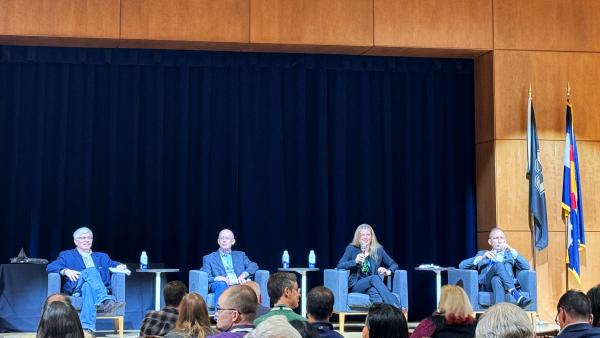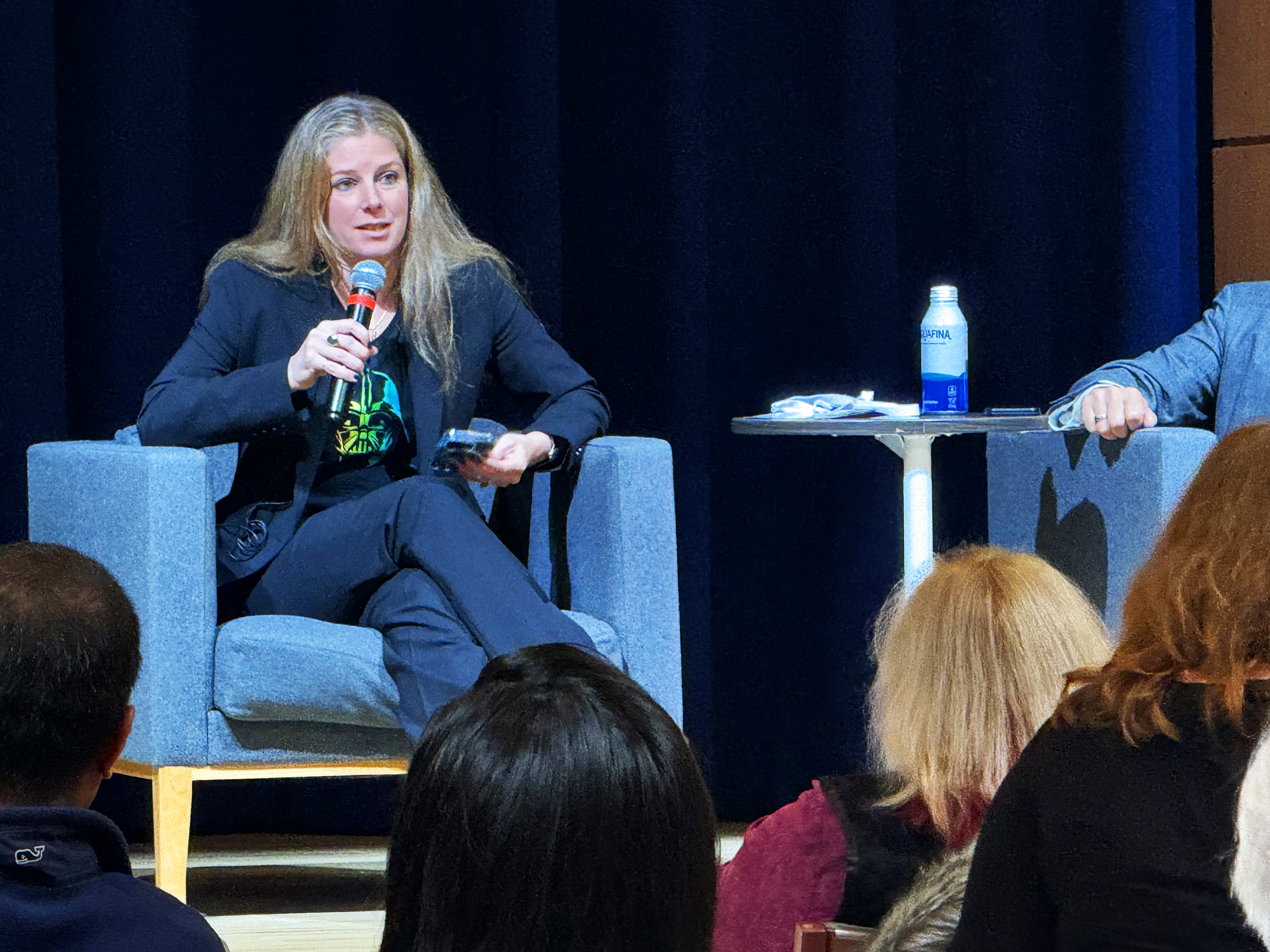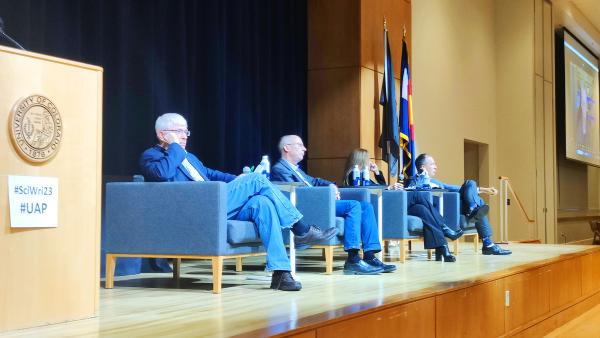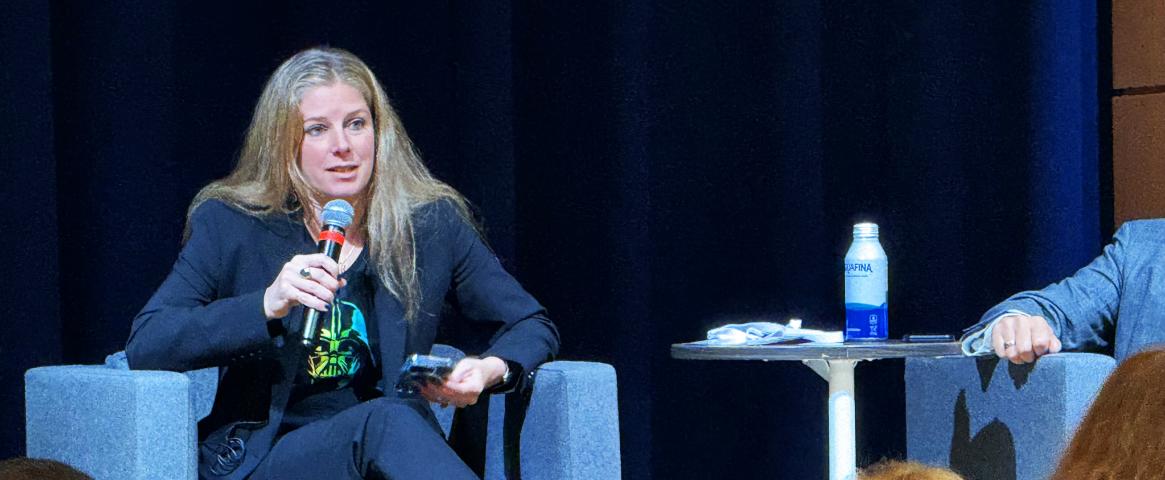Story by Michael E. Newman
Photography by Paul Adepoju and Ankita Arora
How can journalists best cover research on the centuries-old, frequently controversial sightings of the mysterious icons in the skies once known as unidentified flying objects (UFOs) — nowadays more appropriately called unidentified anomalous phenomena (UAPs).
In the “Look! Up in the Sky! It’s not a UFO … it’s a UAP” Science + Science Writing session at the ScienceWriters2023 national conference, four panelists discussed the work of NASA’s Unidentified Anomalous Phenomena Independent Study Team, whose 16 members were — according to the space agency — tasked with providing a roadmap for “applying the tools of science to shed light on the nature and origin of UAPs… separate from NASA’s active astrobiology program that focuses on the origins, evolution and distribution of life beyond Earth.”
In other words, explained session moderator and Scientific American senior opinions editor Dan Vergano, the team’s goal was to focus future NASA studies on identifying UAPs without having to link them to extraterrestrial visitors.
The panel convened by CASW to discuss the NASA effort — and the difficulties of science writers to properly report on it to the public — included Nadia Drake, physics editor at Quanta and a member of the UAP Independent Study Team; Mick West, writer, skeptic and UFO investigator for Metabunk.org; Iain Boyd, director of the Center for National Security Initiatives at the University of Colorado Boulder; and Swiss-American astrophysicist Thomas Zurbuchen, director of ETH Zurich Space and former associate administrator for the Science Mission Directorate at NASA.
 Dan Vergano, Iain Boyd, Nadia Drake, and Thomas Zurbuchen on stage during the ScienceWriters2023 national conference in Boulder. (Paul Adepoju for NASW)
Dan Vergano, Iain Boyd, Nadia Drake, and Thomas Zurbuchen on stage during the ScienceWriters2023 national conference in Boulder. (Paul Adepoju for NASW)
The NASA study team’s report (downloadable at https://science.nasa.gov/uap/) was issued on Sept. 14, 2023. Along with its recommendations on how to scientifically evaluate UAPs and that NASA should appoint a director of UAP research, it also concluded earlier investigations of UAPs had not produced evidence of extraterrestrial life.
First to speak for the panel was Zurbuchen, who described NASA’s three main reasons for convening the UAP study team.
“We knew that these phenomena in our airspace needed to be better understood using the scientific method, we knew that new technologies — especially artificial intelligence [AI] — could do analyses we couldn’t do before, and we knew that NASA needed to show it could do scientifically valid and viable research on a high-risk, high-interest topic,” Zurbuchen explained.
“And we knew that it was critical to put a journalist on the panel to properly communicate to the public what we were doing and build trust in the findings,” he added.
That journalist was Drake, a recognized science communicator and daughter of American astrophysicist and astrobiologist Frank Drake, a pioneer of the search for extraterrestrial intelligence (SETI). The senior Drake is also known for his eponymous equation, a mathematical formula for estimating how many detectable civilizations might possibly exist throughout the Milky Way.
“Unlike SETI and my father’s work, where the goal was to look for life elsewhere, we kept our focus on providing a roadmap for NASA to study UAPs, whatever they are, and independently of whether or not they are associated with extraterrestrials,” said Drake. “So we tried to answer two questions: Is there enough of a ‘science case’ for NASA to do this? and What can NASA do to investigate UAPs that the Defense Department hasn’t already done?”
 Nadia Drake speaks to the audience at the Science + Science Writing session on UAPs during the ScienceWriters2023 national conference in Boulder. (Paul Adepoju for NASW)
Nadia Drake speaks to the audience at the Science + Science Writing session on UAPs during the ScienceWriters2023 national conference in Boulder. (Paul Adepoju for NASW)
To get the necessary scientific data, Drake said the independent study team’s report recommends (1) using Earth-orbiting satellites to gather UAP data, (2) incorporating AI and machine learning to best analyze collected data, (3) conducting a crowdsourcing-like campaign to solicit “citizen observers,” and (4) looking for “technosignatures” — any measurable properties that can provide scientific evidence of a past or present technology — in the universe so that SETI efforts can be directed toward those regions.
Mick West spoke next, praising the study team’s report, saying that non-military investigations — similar to the ones proposed in the report — had already shown they could do a better and faster job than the military at explaining UAP events.
“Besides the obvious problem of some or all data being classified, the military often takes excessively long periods of time to make conclusions and may lack the scientific technology to properly evaluate that data,” said West. “For example, it took me two days of doing 3D graphic analysis on the Gimbal video [footage of a glowing, rotating object taken in 2017 by a military jet pilot and highly touted by UFO enthusiasts as a real sighting] to show that it was likely an artificial effect produced by the camera — the same finding it took the military four years to make.”
The final speaker was Iain Boyd, who said what he found most intriguing about UAPs is how the independent study team and its recommendations for a NASA-led, evidence-based investigation is starting to change the way the public views them.
“Polls in the past showed that Americans were more interested in showing UAPs were evidence of alien life — even if there was a lack of data to support such a connection — rather than just being able to explain scientifically what they are,” said Boyd. “Recent surveys have revealed that public opinion is gradually swinging back the other way, especially with NASA getting involved.”
Boyd continued, saying that an increased public demand for more scientific evidence about UAPs might raise some social, governmental, and policy issues.
“For example, should we opt to equip commercial airliners with sophisticated technology for observing and analyzing UAPs in the slim chance that a plane might encounter one?” he asked. “While that might improve our ability to identify UAPs, one has to wonder if it also might impact quality of service, reduce efficiency, or even endanger passengers.”
Following Boyd’s comments, Vergano turned the panel’s attention to a question that was likely the one most of the session attendees wanted answered: “What is the responsibility of the science writers when communicating about UAPs?”
Nadia Drake began, saying that science writers had to separate the story from the cultural phenomenon. “Look at it critically, put it in proper context, and make sure the information is based on fact and from a credible source,” she explained.
West warned the audience to be wary of sensationalism on this topic and shy away from any source who focuses on whether or not UAPs are extraterrestrial in origin. “A scientific explanation of why people are seeing things in the sky is far more relevant than ‘Is ET visiting us’,” he said.
Thomas Zurbuchen added that if professional science journalists and communicators don’t report on UAPs, it leaves the door open for others without scientific backgrounds and with no real evidence to fill in the gaps. “Credible communicators looking away because UAPs might feel controversial or risky to cover is bad news,” he said.
Boyd agreed, saying that “people who have a true appetite for the facts can easily be taken advantage of by those who don’t have them if science writers don’t feel responsible for reporting this topic.”
Finally, the panel discussed how science writers need to have respect for those brave enough to report UAPs and reduce the stigmatization that has followed such honesty in the past.
“People cannot explain something that they’ve seen and they want to know what it was without feeling that they’ll be ridiculed for acknowledging the event,” Drake said. “The job of science writers is to be sensitive to their fears, show them respect and get their stories documented because that’s the way we’ll get their answers.”
 Panelists on stage on via videoconference listen to audience questions at the Science + Science Writing session on UAPs during the ScienceWriters2023 national conference in Boulder. (Ankita Arora for NASW)
Panelists on stage on via videoconference listen to audience questions at the Science + Science Writing session on UAPs during the ScienceWriters2023 national conference in Boulder. (Ankita Arora for NASW)
Michael E. Newman (@MENewman17) is a broad-based communicator with an extensive and award-winning record in three branches of communications – public affairs, journalism, and broadcast/online media. His 40-plus-year career has included full-time positions and freelance work in science and medical communications, corporate public relations, broadcast TV and radio, and mass market publications.
Paul Adepoju (@pauladepoju) is a freelance journalist and editor, author, and media trainer based in England, with bylines in health and medical stories for Nature, Scientific American, Devex, Insider, The Lancet, Health Policy Watch, New Scientist, and other publications.
Ankita Arora (LinkedIn) is a freelance science writer and formerly a postdoctoral fellow at the University of Colorado Anschutz Medical Campus. Her work has been featured in ASBMB Today, Scientific American, Colorado Sun, and other outlets. She is a science communication and policy enthusiast focusing on diversity, health, and immigration solutions.
This ScienceWriters2023 conference coverage article was produced as part of the NASW Conference Support Grant awarded to Newman, Adepoju, and Arora to attend the ScienceWriters2023 national conference. Find more 2023 conference coverage at www.nasw.org
A co-production of the National Association of Science Writers (NASW), the Council for the Advancement of Science Writing (CASW), University of Colorado Boulder, and the University of Colorado Anschutz Medical Campus, the ScienceWriters2023 national conference featured an online portion Sept. 26-Oct. 3, followed by an in-person portion held in Boulder and Anschutz, Colo., Oct. 6-10. Learn more at www.sciencewriters2023.org and follow the conversation on social media at #SciWri23
Credits: Reporting by Michael E. Newman; edited by Ben Young Landis. Photography by Paul Adepoju and Ankita Arora; edited by Ben Young Landis.

